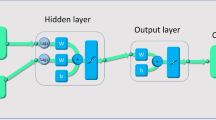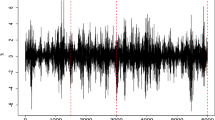Abstract
We present a detailed analysis of observable moment-based parameter estimators for the Heston SDEs jointly driving the rate of returns \((R_{t})\) and the squared volatilities \((V_{t})\). Since volatilities are not directly observable, our parameter estimators are constructed from empirical moments of realised volatilities \((Y_{t})\), which are of course observable. Realised volatilities are computed over sliding windows of size \(\varepsilon \), partitioned into \(J(\varepsilon )\) intervals. We establish criteria for the joint selection of \(J(\varepsilon )\) and of the subsampling frequency of return rates data.
We obtain explicit bounds for the \(L^{q}\) speed of convergence of realised volatilities to true volatilities as \(\varepsilon \to 0\). In turn, these bounds provide also \(L^{q}\) speeds of convergence of our observable estimators for the parameters of the Heston volatility SDE.
Our theoretical analysis is supplemented by extensive numerical simulations of joint Heston SDEs to investigate the actual performances of our moment-based parameter estimators. Our results provide practical guidelines for adequately fitting Heston SDE parameters to observed stock price series.





Similar content being viewed by others
References
Aït-Sahalia, Y.: Maximum likelihood estimation of discretely sampled diffusions: a closed-form approximation approach. Econometrica 70, 223–262 (2002)
Aït-Sahalia, Y.: Closed-form likelihood expansions for multivariate diffusions. Ann. Stat. 36, 906–937 (2008)
Aït-Sahalia, Y., Kimmel, R.: Maximum likelihood estimation of stochastic volatility models. J. Financ. Econ. 83, 413–452 (2007)
Aït-Sahalia, Y., Mykland, P.A., Zhang, L.: How often to sample a continuous-time process in the presence of market microstructure noise. Rev. Financ. Stud. 18, 315–416 (2005)
Alizadeh, S., Brandt, M.W., Diebold, F.X.: Range-based estimation of stochastic volatility models. J. Finance 57, 1047–1091 (2002)
Azencott, R., Beri, A., Jain, A., Timofeyev, I.: Sub-sampling and parametric estimation for multiscale dynamics. Commun. Math. Sci. 11, 939–970 (2013)
Azencott, R., Beri, A., Timofeyev, I.: Adaptive sub-sampling for parametric estimation of Gaussian diffusions. J. Stat. Phys. 139, 1066–1089 (2010)
Azencott, R., Beri, A., Timofeyev, I.: Parametric estimation of stationary stochastic processes under indirect observability. J. Stat. Phys. 144, 150–170 (2011)
Azencott, R., Gadhyan, Y.: Accurate parameter estimation for coupled stochastic dynamics. In: Hou, X., et al. (eds.) Proc. 7th AIMS International Conference on Dynamical Systems, Differential Equations and Applications, pp. 44–53. American Institute of Mathematical Sciences, Clothcover (2009)
Azencott, R., Gadhyan, Y.: Accuracy of maximum likelihood parameter estimators for Heston stochastic volatility SDE. J. Stat. Phys. 159, 393–420 (2015)
Azencott, R., Ren, P., Timofeyev, I.: Parametric estimation from approximate data: non-Gaussian diffusions. J. Stat. Phys. 161, 1276–1298 (2015)
Bandi, F., Russell, J.: Separating microstructure noise from volatility. J. Financ. Econom. 79, 655–692 (2006)
Barndorff-Nielsen, O.E., Shephard, N.: Econometric analysis of realized volatility and its use in estimating stochastic volatility models. J. R. Stat. Soc., Ser. B 64, 253–280 (2002)
Basawa, I.V., Prakasa Rao, B.L.S.: Statistical Inference for Stochastic Processes. Academic Press, New York (1980)
Bates, D.S.: Maximum likelihood estimation of latent affine processes. Rev. Financ. Stud. 19, 909–965 (2006)
Ben Alaya, M., Kebaier, A.: Asymptotic behavior of the maximum likelihood estimator for ergodic and nonergodic square-root diffusions. Stoch. Anal. Appl. 31, 552–573 (2013)
Berkaoui, A., Bossy, M., Diop, A.: Euler scheme for SDEs with non-Lipschitz diffusion coefficient: strong convergence. ESAIM Probab. Stat. 12, 1–11 (2008)
Bollerslev, T., Zhou, H.: Estimating stochastic volatility diffusion using conditional moments of integrated volatility. J. Econom. 109, 33–65 (2002)
Burgess, D.: On the \(L^{p}\) norms of stochastic integrals and other martingales. Duke Math. J. 43, 697–704 (1976)
Christensen, K., Oomen, R.C.A., Podolskij, M.: Realised quantile-based estimation of the integrated variance. J. Econom. 159, 74–98 (2010)
Christensen, K., Podolskij, M., Vetter, M.: Bias-correcting the realized rangebased variance in the presence of market microstructure noise. Finance Stoch. 13, 239–268 (2009)
Comte, F., Genon-Catalot, V., Rozenholc, Y.: Nonparametric adaptive estimation for integrated diffusions. In: Stochastic Processes and Their Applications, vol. 119, pp. 811–834 (2009)
Cox, J.C., Ingersoll, J.E., Ross, R.A.: A theory of the term structure of interest rates. Econometrica 53, 385–407 (1985)
Crommelin, D., Vanden-Eijnden, E.: Diffusion estimation from multiscale data by operator eigenpairs. Multiscale Model. Simul. 9, 1588–1623 (2011)
Duffie, D., Singleton, K.J.: Simulated moments estimation of Markov models of asset prices. Econometrica 61, 929–952 (1993)
Feller, W.: The asymptotic distribution of the range of sums of independent random variables. Ann. Math. Stat. 22, 427–432 (1951)
Genon-Catalot, V.: Maximum contrast estimation for diffusion processes from discrete observations. Statistics 21, 99–116 (1990)
Genon-Catalot, V., Jeantheau, T., Laredo, C.: Parameter estimation for discretely observed stochastic volatility models. Bernoulli 5, 855–872 (1999)
Gloter, A.: Discrete sampling of an integrated diffusion process and parameter estimation of the diffusion coefficient. ESAIM, Probab. Stat. 4, 205–227 (2000)
Gloter, A.: Efficient estimation of drift parameters in stochastic volatility models. Finance Stoch. 11, 495–519 (2007)
Heston, S.L.: A closed-form solution for options with stochastic volatility with applications to bond and currency options. Rev. Financ. Stud. 6, 327–343 (1993)
Hoffmann, M.: Rate of convergence for parametric estimation in a stochastic volatility model. In: Stochastic Processes and Their Applications, vol. 97, pp. 147–170 (2002)
Kalnina, I.: Subsampling high frequency data. J. Econom. 161, 262–283 (2010)
Mariani, F., Pacelli, G., Zirilli, F.: Maximum likelihood estimation of the Heston stochastic volatility model using asset and option prices: an application of nonlinear filtering theory. Optim. Lett. 2, 177–222 (2008)
Papavasiliou, A., Pavliotis, G.A., Stuart, A.: Maximum likelihood drift estimation for multiscale diffusions. In: Stochastic Processes and Their Applications, vol. 119, pp. 3173–3210 (2009)
Pavliotis, G.A., Stuart, A.: Parameter estimation for multiscale diffusions. J. Stat. Phys. 127, 741–781 (2007)
Phillips, P.C.B., Yu, J.: Maximum likelihood and Gaussian estimation of continuous time models in finance. In: Mikosch, T., et al. (eds.) Handbook of Financial Time Series, pp. 497–530. Springer, Berlin (2009)
Ruiz, E.: Quasi-maximum likelihood estimation of stochastic volatility models. J. Econom. 63, 289–306 (1994)
Zhang, L., Mykland, P.A., Aït-Sahalia, Y.: A tale of two time scales: determining integrated volatility with noisy high-frequency data. J. Am. Stat. Assoc. 100, 1394–1411 (2005)
Acknowledgements
I.T. and R.A. were supported in part by the NSF Grant DMS-1109582. I.T. is also partially supported by the NSF Grant DMS-1620278.
Author information
Authors and Affiliations
Corresponding author
Additional information
Publisher’s Note
Springer Nature remains neutral with regard to jurisdictional claims in published maps and institutional affiliations.
Appendix: Polynomial functions of volatilities and Theorem 7.1
Appendix: Polynomial functions of volatilities and Theorem 7.1
Proof of Theorem 7.1
By linearity, we only need to consider the case when \(h\) is a monomial in \(k\) variables. For \(k=1\), the result was proved in (6.4). Proceeding by induction on \(k\), assume the result is true for monomials in \(k-1\) variables \((x_{2}, \ldots , x_{k})\). Any monomial \(h\) in \(k\) variables can be written as \(h = x_{1}^{m} g(x_{2}, \ldots , x_{k})\). Define
The induction hypothesis provides a polynomial \(R\) in \(k+1\) variables such that for all \(T\),
where the coefficients of \(R\) are determined by \(g, \boldsymbol{\theta }\). By the Markov property, we thus get
Since \({\mathbb{E}}_{y} [H_{T}] = {\mathbb{E}}_{y} [ V_{u(1)+T}^{m} { \mathbb{E}}[G_{T} | {\mathcal{F}}_{u(1) +T}] ] \), we then obtain
Each monomial \(M\) of \(R\) is of the form \(\nu _{T}^{p} (V_{u(1) +T} \nu _{T})^{j} S(w_{1}, w_{2}, \ldots , w_{k-1})\) for some \(p\), \(j\) and some polynomial \(S\). Then on the right-hand side of (7.4), \(M\) contributes a term of the form
Due to (6.4) with \(q= m+j\), this last conditional expectation is a polynomial in the two variables
with coefficients depending only on \(m+j\) and \(\boldsymbol{\theta }\). Hence \(\Gamma (M)\) is a polynomial in \(\nu _{T}\) and \(y \nu _{T}\), with coefficients which are polynomials in \((w_{0}, w_{1}, w_{2}, \ldots , w_{k-1}) \), fully determined by \(m\), \(j\), \(\boldsymbol{\theta }\). The same property must then hold for the sum \({\mathbb{E}}_{y}[H_{T}]\) of all the \(\Gamma (M)\) contributed by the monomials \(M\) of \(R\). This completes the proof of (7.4) by induction on \(k\).
Write \({\mathrm{POL}}\) in (7.4) as a polynomial \({\mathrm{POL}}(z)\) in the \(k+2\) variables \(z_{i}\). The vector \(z(T) = (\nu _{T}, y \nu _{T}, w_{0}, \ldots , w_{k-1})\) tends to \(z(\infty ) = (0, 0, w_{0}, \ldots , w_{k-1})\) as \(T \to \infty \). The polynomial \(Q(z(T)) = {\mathrm{POL}}(z(T)) - {\mathrm{POL}}(z(\infty ))\) can be written, for some integer \(p\), as
with each \(A_{s}\) a polynomial in the \(k+1\) variables \((\nu _{T}, w_{0}, \ldots , w_{k-1})\) for \(s=0, \ldots , p\). Since all these positive \(k+1\) variables are inferior to 1, each \(|A_{s}|\) remains bounded for all \(T \geq 0\) and all \(u(0) < u(1) < \cdots < u(k)\). Hence there is a constant \(C\) such that
For all \(s \geq 1\), we have \(\nu _{T}^{s} \leq \nu _{T}= e^{-T \kappa }\), and hence the expansion of \(Q(z(T))\), provides a new constant \(C_{1}\) such that for all \(u(0) < u(1) < \cdots < u(k)\),
This proves (7.6).
Let \({\overline{H}}= {\mathbb{E}}_{\psi }[H]\). Expand \(\beta (T) = (H_{T} - {\overline{H}})^{q}\) as a linear combination of terms of the form \({\overline{H}}^{q-j} H_{T}^{j} \) for \(j= 0, \ldots , q\). Recall that \(h\) is a polynomial in \(x_{1}, x_{2}, \ldots , x_{k}\). For \(j\) fixed, \(\sigma _{j} = h^{j}\) is also a polynomial in \(x_{1}, x_{2}, \ldots , x_{k}\). By the definition (7.3), we can express both \(\Sigma = H^{j}\) and \(\Sigma _{T} = H_{T}^{j}\) as
For each \(j\), (7.6) applied to the polynomial \(\sigma = h^{j}\) provides a constant \(C_{j}\) and an integer \(p(j)\) such that
and hence there are constants \(c_{j}\) such that
Applying this to \(j= 0, \ldots , q\) and using the Newton binomial formula yields, for some new constant \(C\),
which completes the proof of (7.5). □
Rights and permissions
About this article
Cite this article
Azencott, R., Ren, P. & Timofeyev, I. Realised volatility and parametric estimation of Heston SDEs. Finance Stoch 24, 723–755 (2020). https://doi.org/10.1007/s00780-020-00427-2
Received:
Accepted:
Published:
Issue Date:
DOI: https://doi.org/10.1007/s00780-020-00427-2




